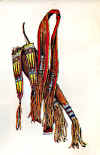 Crow bow case &
quiver
Crow bow case &
quiverNative Americans and Anthropologists
Home | Fall | Spring/Summer | AIS | AS
| Anthro
When Europeans first set foot on American shores they were amazed at a unique landscape that included stange creatures like the hummingbird and opposum; as well as an unknown, exotic, people. The strangeness was somewhat due to the relative isolation and ignorance of the Europeans in early times, but also due to the fact that early writers were not primary observers and manipulated images for their audiences. Yet, America did not easily fit into known Biblical or antiquarian notions about the world. During the colonial period and in the early days of this nation various scholars began to speculate about Native American people. Most of the early 'armchair' scholars in Europe tended to skew their perception of America to be inferior in people and environment. Since 18th century European thinking saw the environment as the primary deterministic factor in molding culture, it was even assumed that an inferior American environment would have a degenerative effect on European immigrants and that further explained the rebellious attitude among the colonists. Although influenced by such European 'Enlightenment' early Euro-Americans began to react, with Thomas Jefferson defending the American environment and its inhabitants in his report to the French, Notes on the State of Virginia (1787). Other Americans like Winthrop Jordan, Benjamin Smith Barton, and Benjamin Rush followed suit. However, as more land and resources were coveted by colonists at the end of the 18th century, it became more convienent to question the rights of Native Americans. A debate had also emerged as to what people were responsible for the construction of over 100,000 mounds and earthworks throughout Eastern North America. The place that American Indians filled in emerging questions about human evolution were complicated by Euro-American arrogance and racism coupled with increasing pressure to expand a frontier as one of the greatest mass migrations of people to America was building to a peak in the late 19th and early twentieth centuries. Some scholars were beginning to criticize the Biblical concept of the unity of mankind or monogenism and explain cultural differences and Native American rebelliousness as evidence that Native Americans and other cultures were derived from a separate species or polygenism. One can also see that some of this leads to further justification of inservitude and slavery. Even monogenists felt that Native Americans and other cultures should be taught and expected to convert to 'civilization' or Euro-American culture. The early American scholars involved in such debates set the stage for the development of the American versions of the anthropological fields such as ethnology, linguistics, craniology, and archaelogy. These early scholarly writings appear relatively reasonable in some cases and very wrong in others. Some, like Dr. Samuel Morton,have been shown to have purposely falsified measurements of human skull volumes to generate a false picture that Europeans were superior based on the equally false notion that cranial capacity is a measure of relative intelligence (see also, Repatriation). Most of these early scholars reflected the bias of the inevitability of the displacement of the American Indian and their conversion to a predominantly European cultural ideal. Here is a list of some of these early scholars of Native American people and culture.
NAME |
DATES |
THEORETICAL |
AFFILIATIONS |
| Thomas Jefferson | 1743-1826 | monogenist | American Philosophical Society, Univ. of Virginia, U.S. Pres. 1801-09, surveyor,etc. |
| Albert Gallatin | 1761-1849 | monogenist | U.S. Senate1793,Sec. of Treas. 1801, Bur. of Indian Affairs, Am.Antiquarian Soc.,linguistics |
| Samuel G.Morton | 1799-1861 | polygenist | physician, Phila, PA, Am. Philosophical Soc.,Acad. of Nat. Sciences, craniology |
| Ephraim G. Squier | 1821-1888 | polygenist | Am. Antiquarian Soc.,Am. Ethno. Soc.,surveyed mounds |
| Henry R. Schoolcraft | 1793-1864 | polygenist | U.S. govt. geologist and local Indian Agent, ethnology, folklore |
| Lewis H. Morgan | 1818-1881 | monogenist | Am. Assoc.for the Adv. of Science,Ely S. Parker (Seneca), NY Hist. Soc.,ethnology esp kinship |
| John W. Powell | monogeneist | 1st Dir. of US Geological Survey and Bur. of Amer. Ethnology (BAE) |
John Wesley Powell with his vision of the Bureau of American Ethnology(BAE) and its establishment in 1879 ecame the primary link for the development of professional anthropology in America. The initial contributors were a mix of amateurs, antiquarians, early professionals. It became clear to Powell and others that methods of archaeological field excavation required controlled stratigraphy and documentation. As the Smithsonian Museum and the Bureau of American Ethnology developed the expectation of university trained staff a mutual incentive for the formation of the early departments of anthropology at American universities was established.